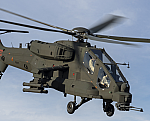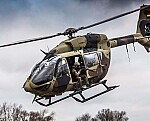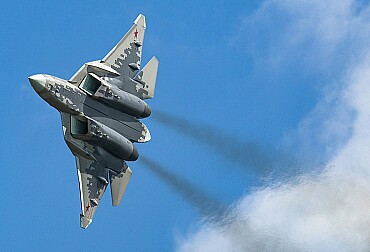Despite it came from the realm of evil the Su-27 was a beautiful answer to the F-15
In most conflicts, fighters have been designed to counter those of the enemy, and the Cold War was no exception. And so, faced with the McDonnell F-15A/B Eagle, the USSR responded with the Sukhoi Su-27 Flanker, while the Su-27P Flanker-B was the answer to the McDonnell-Douglas F-15C/D Eagle. In both the United States and the Soviet Union, these two aircraft were resounding successes, setting benchmarks of their time.
The Su-27 Flanker
The Sukhoi Su-27 Flanker made its first Western appearance at the Paris Air Show in 1989. Its first prototype, the failed T-10, was designed in 1977 and evolved into the much more promising T-10S. Proof of its great potential, it gave birth to an impressive family of combat aircraft. The large number of versions subsequently developed shows that the basic structure and aerodynamic configuration chosen at the outset were very sound, even though numerous modifications were made. Designed as an interceptor and long-range fighter, its range, performance and powerful radar make it of comparable efficiency to the early Boeing F-15 Eagle. It is powered by two AL-31F engines and is made from a lightweight aluminum alloy. Yet the Su-27 remains a very large and heavy aircraft.
The Su-27 is known for its magnificent maneuver called the Cobra, a manoeuvre in which the aircraft reaches an incidence of of 120°, going from 450km/h to 120km/h in 3 seconds and representing its excellent manoeuvrability linked to a complex fly-by-wire control system. The pilot has a helmet-mounted sight and the Su-27 can carry 10 Archer R-73 or R-27 air-to-air missiles. The Su-27 can also fly very fast at very high altitudes. Its long-range pulse Doppler radar enables it to guide missiles to their targets.
The disadvantage of the Su-27 is its impractical avionics, consisting of a host of dials that do not fit in with modern avionics systems. Although they remain complete and functional, they require more attention. What's more, it can't carry active radar-guided missiles, which means it has to hold on to its target until impact, and it can't engage several targets simultaneously. It has a 30mm-calibre GSh-301 cannon and can carry radar-guided or non-radar-guided bombs for air-to-ground attacks.
The Flanker-A is the T-10, the first prototype. Next came the Su-27 Flanker-B, the modified version. Between 1986 and 1988, a modified Su-27 designated P-42 broke 27 records for climb speed and altitude, including the record for the highest altitude for a fighter. Many of these records belonged to the Boeing F-15A. The Flanker-C is a two-seat trainer version with identical combat capabilities. The Flanker-D is the naval version designed to equip the squadrons of the Russian aircraft carrier Admiral Kuznetsov, and later became better known as the Sukhoi Su-33. It differs from the other versions in that it has reinforced landing gear, folding wings and a tailhook. The Flanker-F and G, also known as the Sukhoï Su-30, are two-seater multi-role versions that are widely exported. The Su-27IB Fullback, or Su-34, is a two-seat side-by-side ground attack version. Finally, the Flanker-E or Su-35 Super Flanker is a highly modernised version, especially in terms of avionics, equipped with thrust vectoring nozzles.
The Su-27 has had some export success in the former Communist bloc countries of Abkhazia, Armenia, Belarus, China, Kazakhstan, Uzbekistan, Ukraine and Vietnam, as well as in Algeria, Angola, Eritrea, Ethiopia, India, Indonesia, Malaysia, Moldova and Yemen. The United Kingdom and the United States are also said to have acquired at least one Su-27 each, the former through a deal with Ukraine, the latter with Belarus to equip the Red Eagles squadron, known as Aggressors before the fall of the USSR.
The Su-27s were involved in several diplomatic incidents between the two blocs during the Cold War, as they were first used in the USSR and the People's Democracies. Since then, they have been used mainly in conflicts between developing countries, particularly in Africa. Estimates put the number of aircraft built at 700. Before Russia attacked Ukraine, it had 25 aircraft in the AVMF (naval aviation), 130 in the VVS (front-line aviation), and 300 in the PVO (air defense). To these must be added the aircraft used by the acrobatic patrol of the Russian Knights. According to actual information, so far Russia has lost 3 Su-27s, while Ukraine Air Force has lost 24 of these aircraft, out of a total of 31 aircraft that were deployed.
The F-15 Eagle
In service for almost 50 years (introduced in 1976), the F-15 Eagle remains surely one of the best fighter aircraft in the world even today. It is fast, extraordinarily manoeuvrable and agile in combat, capable of rocket-like climbing and equipped with the best operational combat radar, enabling it to locate, intercept and destroy beyond the horizon. It's hard to beat the F-15 on an interception mission, which takes off in 300 m and has a rate of climb of 17,500 m/min, reaching an altitude of 20,000 m just 2 minutes after take-off. With a service ceiling of 35,000 m and mission distances of 1,600 km without refuelling, it is also capable of intercepting reconnaissance aircraft at great distance.
Its armament, comprising 4 AIM-7 Sparrow missiles, 2 AIM-9 Sidewinder missiles, 2 AIM-120 AMRAAM missiles and the M61 Vulcan cannon, makes it invulnerable in close combat as well as to destruction from a distance. Improvements have given it more powerful engines, enhanced electronics and the adoption of FAST (Fuel And Sensor Tactical-Pack) pods. In addition, external fuel tanks now allow it to increase its fuel-carrying capacity by almost 75%. Finally, the installation of the APG-70 ultra-high-performance radar enables the detection of all types of aircraft despite low speed and various types of interference and includes a low-altitude terrain-following mode.
The United States has taken into account around 400 F-15A and B aircraft and more than 500 more powerful F-15C and D aircraft. This aircraft, which is also used by Israel, Saudi Arabia and Japan, has an impressive fighter record (with more than 100 aircraft destroyed), while no Eagle has ever been destroyed in combat. An attack version, the F-15E Strike Eagle, has been developed in view of the extraordinary versatility of this fighter-interceptor. Finally an air superiority version appeared in the 21st century: the Boeing F-15EX Eagle II.








